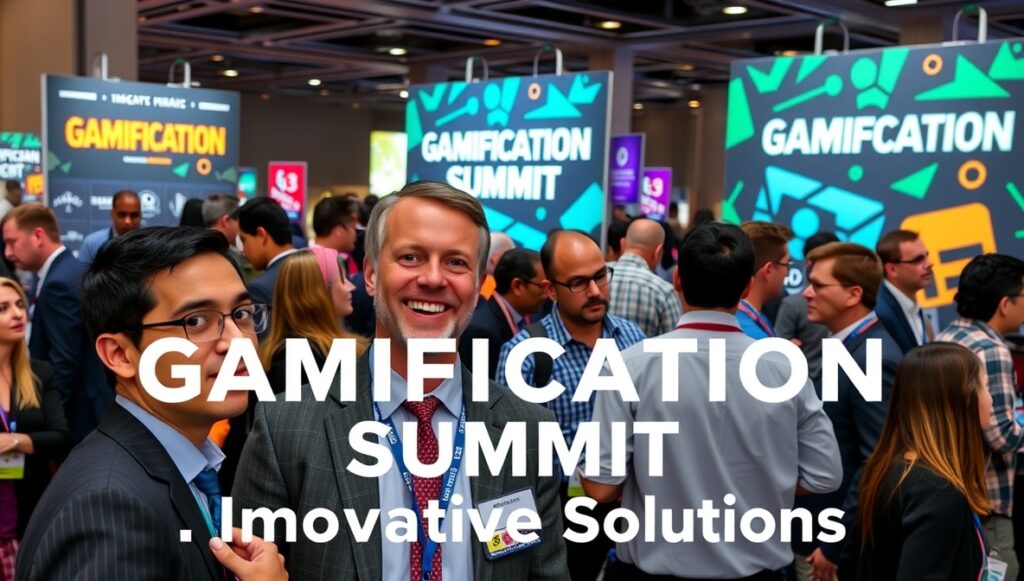gamificationsummit professionals eager to revolutionize digital engagement have observed a remarkable evolution in how people learn, work, and interact through game-based systems. In recent years, gamification has moved beyond simple reward systems and points—it has become a central pillar in modern business strategies, education, marketing, and even healthcare. The concept has proven its ability to turn ordinary experiences into motivating, interactive, and productive ones. This article explores how gamification is shaping the future, driving innovation, and reshaping human behavior across multiple sectors.
Understanding the Power of Gamification
Gamification is the process of integrating game mechanics—such as achievements, progress bars, badges, leaderboards, and challenges—into non-game environments. gamificationsummit professionals eager to explore the psychology behind motivation believe that gamification taps into fundamental human desires for achievement, recognition, and social connection. These principles have made gamification a powerful strategy in improving engagement across platforms, from corporate training programs to mobile fitness apps. ontpinvest
Gamification appeals to intrinsic and extrinsic motivations alike. Intrinsically, people feel satisfied by mastery, competence, and progress. Extrinsically, they are motivated by rewards and recognition. When both are aligned through thoughtful design, the result is a sustainable engagement model that benefits both organizations and individuals.
Gamification in the Workplace
The professional world has embraced gamification with enthusiasm. Organizations now use gamified platforms to boost employee motivation, enhance training outcomes, and improve productivity. gamificationsummit professionals eager to harness the full potential of workplace engagement recognize that incorporating elements of play doesn’t trivialize work—it humanizes it.
For instance, sales departments often implement leaderboards that track performance metrics, encouraging friendly competition and continuous improvement. Similarly, onboarding programs that reward employees for completing milestones can reduce training time and increase knowledge retention. This blend of competition and collaboration cultivates a culture of achievement that motivates employees without enforcing rigid control.
Companies like Deloitte, IBM, and Microsoft have demonstrated how gamification can enhance employee learning programs, improve collaboration, and create an innovative workplace atmosphere. The data-driven approach allows managers to measure engagement and performance more effectively, translating motivation into measurable results. uploadblog
Education and Learning Reimagined
Gamification has transformed education from passive learning into active participation. gamificationsummit professionals eager to redefine traditional education systems emphasize how gamified methods can enhance comprehension, creativity, and critical thinking among students. The idea is simple—when learning feels like playing, it becomes more enjoyable and effective.
Educational apps such as Duolingo, Kahoot!, and Quizizz exemplify this transformation. They use points, badges, and streaks to reward consistent learning behavior. Students become motivated not only by grades but also by the sense of progress and personal achievement. This approach nurtures curiosity, strengthens long-term retention, and helps learners set and achieve realistic goals. rcsdassk
Gamified classrooms are no longer confined to children. In universities and professional training settings, gamified learning management systems are enhancing engagement among adults. Learners take ownership of their progress, and educators gain tools to monitor performance dynamically.

Marketing and Customer Engagement
Brands have discovered that gamification can be an extraordinary tool to captivate audiences. gamificationsummit professionals eager to improve consumer loyalty and brand experience often integrate gamified campaigns to create emotional connections with users. The underlying principle is engagement—by making customers part of the experience, brands can cultivate long-term loyalty.
For example, Starbucks uses its rewards program to gamify coffee purchases, offering stars and levels that unlock free items and exclusive privileges. Nike+ and Fitbit use gamification to motivate users toward fitness goals. Each milestone achieved reinforces brand loyalty while promoting healthy behaviors. These programs demonstrate how gamification can simultaneously serve customer satisfaction and corporate success.
Gamification also shines in digital marketing. Interactive challenges, referral rewards, and social media badges make consumers active participants rather than passive observers. Businesses in the United States and beyond have adopted gamification as a core strategy to boost customer engagement and data collection. The results speak for themselves: higher retention rates, stronger emotional bonds, and enhanced brand advocacy. woiismivazcop
Healthcare and Wellness Through Play
In healthcare, gamification has redefined patient engagement and well-being. gamificationsummit professionals eager to merge technology with behavioral science have developed tools that encourage patients to adopt healthier lifestyles. From fitness trackers to mobile health apps, gamified approaches empower users to take control of their health.
Applications like MyFitnessPal, Fitbit, and Apple Health use badges, challenges, and progress tracking to make fitness enjoyable. These features transform mundane activities such as walking or exercising into rewarding experiences. Healthcare providers have also incorporated gamification into therapy, rehabilitation, and chronic disease management programs, leading to improved adherence and outcomes.
Beyond physical health, gamification supports mental wellness as well. Apps designed for mindfulness, such as Headspace, use streaks and milestones to motivate users to practice regularly. This shows that gamification isn’t just about fun—it’s about fostering consistency, discipline, and positive habits.
The Psychology Behind Gamification
Understanding the success of gamification requires an appreciation of its psychological foundation. gamificationsummit professionals eager to understand behavioral drivers often refer to theories such as Self-Determination Theory (SDT) and Behavioral Conditioning. SDT suggests that humans are naturally motivated when they experience autonomy, competence, and relatedness. Gamified systems fulfill these psychological needs by providing meaningful feedback and challenges.
Rewards, recognition, and social comparison are key elements that sustain engagement. However, gamification’s true power lies in the feeling of progress. Every badge earned or milestone achieved provides instant gratification, reinforcing desired behaviors. When designed ethically and purposefully, gamification becomes a tool for empowerment rather than manipulation.
Gamification in Corporate Training
Corporate learning programs have witnessed a renaissance through gamification. gamificationsummit professionals eager to revamp outdated training models recognize that gamification enhances both engagement and knowledge retention. Traditional training methods often fail to captivate employees, leading to low participation rates and poor skill application.
By introducing gamified learning paths, employees become active participants. Points and badges reward progress, while scenario-based challenges simulate real-life decisions. This experiential learning promotes problem-solving skills and collaboration among team members. The result is not only higher engagement but also measurable business performance improvement.
Furthermore, gamified learning systems generate valuable analytics. Employers can track progress, identify skill gaps, and tailor future training sessions accordingly. This data-driven insight turns gamification into both a motivational and diagnostic tool.
Social Impact and Community Building
Gamification has transcended corporate and educational boundaries—it’s now a key driver of social impact initiatives. gamificationsummit professionals eager to create meaningful change leverage gamified platforms to raise awareness and encourage participation in social causes. From environmental conservation apps to volunteer reward programs, gamification inspires individuals to contribute to the greater good.
For instance, recycling initiatives often use leaderboards and point systems to motivate communities to adopt sustainable behaviors. Social fitness challenges encourage participants to walk or cycle for charity. These programs highlight how gamification can transform passive support into active engagement.
Online communities also thrive through gamification. Platforms like Reddit, Stack Overflow, and online forums use badges, reputation points, and levels to promote quality contributions. These mechanisms reward constructive behavior and create self-sustaining ecosystems built on trust and participation.
Gamification and Technology Integration
The integration of artificial intelligence, virtual reality, and blockchain has opened new possibilities for gamification. gamificationsummit professionals eager to explore the intersection of these technologies envision immersive and secure gamified ecosystems. Virtual reality allows for deeply engaging experiences, from virtual classrooms to simulated corporate environments. AI, on the other hand, personalizes gamified content by adapting challenges based on user behavior.
Blockchain ensures transparency and trust in reward systems. It enables verifiable digital assets—like tokens or achievements—that can be exchanged or showcased across platforms. This technological synergy extends gamification beyond entertainment into finance, real estate, and governance.
The rise of metaverse platforms amplifies gamification’s influence even further. Gamified economies, avatars, and reward systems make digital spaces more engaging and economically viable. This convergence of technology and psychology promises a future where every digital experience becomes rewarding and interactive.
Challenges and Ethical Considerations
Despite its promise, gamification is not without challenges. gamificationsummit professionals eager to apply gamification responsibly must address issues like over-reliance on rewards, addiction, and manipulation. Poorly designed gamification can lead to burnout or exploit users’ attention. Ethical gamification emphasizes autonomy, transparency, and consent.
Another challenge lies in sustainability. When rewards lose novelty, engagement can decline. Therefore, designers must continually evolve systems to maintain user interest. Balancing fun with functionality ensures that gamification remains meaningful over time.
Moreover, cultural sensitivity plays a vital role. What motivates one group might not resonate with another. Understanding diverse motivations, preferences, and values is essential for global adoption.
Future of Gamification: What Lies Ahead
The future of gamification looks promising. gamificationsummit professionals eager to pioneer new engagement models foresee an era where gamified experiences become seamlessly integrated into daily life. From personalized learning environments to gamified urban systems, the possibilities are limitless.
In education, AI-driven gamification will personalize learning experiences like never before. In business, adaptive gamified dashboards will guide employees toward performance excellence. In healthcare, gamified biosensors will motivate patients to manage their health proactively.
Furthermore, as society becomes increasingly digital, gamification will serve as a bridge between human motivation and technological innovation. It will enhance communication, promote inclusivity, and create opportunities for lifelong learning.
Economic and Business Impact
Gamification is not just about engagement—it’s an economic powerhouse. gamificationsummit professionals eager to analyze market trends note that global spending on gamification solutions continues to grow annually. Industries across education, retail, healthcare, and finance have invested heavily in gamified experiences to retain users and drive profits.
Businesses that adopt gamification report increased customer loyalty, higher productivity, and better learning outcomes. Startups and established corporations alike recognize gamification’s ROI potential. As digital competition intensifies, gamification provides a sustainable advantage by focusing on human emotion and motivation.
Case Studies: Success Through Gamification
Real-world case studies demonstrate gamification’s transformative impact. gamificationsummit professionals eager to learn from success stories often reference companies like Nike, Duolingo, and SAP. Nike’s fitness challenges foster a global community of athletes; Duolingo turns language learning into a daily game; SAP’s gamified training platform enhances employee development.
Each success story shares a common thread—user engagement through purpose-driven design. These initiatives go beyond surface-level fun; they align user goals with organizational objectives. This balance ensures long-term participation and satisfaction.
Governmental institutions have also experimented with gamification. Civic apps that reward citizens for responsible behavior—such as paying taxes on time or reporting environmental issues—illustrate gamification’s potential in governance.
The Cultural Shift
Gamification reflects a broader cultural shift toward interactive and personalized experiences. gamificationsummit professionals eager to understand this transformation recognize that today’s digital generation expects participation, not passivity. The success of gamified systems mirrors changing attitudes toward learning, work, and entertainment.
In a world saturated with digital content, gamification cuts through the noise by providing meaning and progress. Whether in a classroom, workplace, or mobile app, gamified systems engage people by acknowledging their efforts and celebrating their achievements. This cultural shift represents a new paradigm in human-computer interaction.

Conclusion
gamificationsummit professionals eager to redefine engagement have unlocked one of the most powerful forces in modern society—the desire to play, achieve, and connect. From education and business to healthcare and social causes, gamification bridges the gap between technology and motivation. Its potential to inspire participation and sustain behavior change makes it a cornerstone of the digital future.
As we move forward, the challenge lies in designing gamified systems that are ethical, inclusive, and meaningful. When done right, gamification not only entertains but empowers. It transforms everyday interactions into opportunities for growth and connection—reminding us that behind every game mechanic lies a deeply human desire: to learn, to achieve, and to belong.


